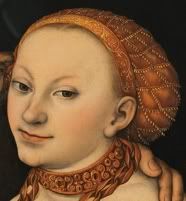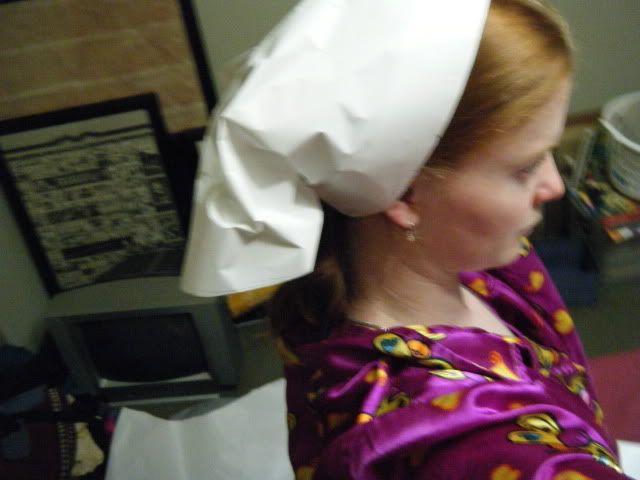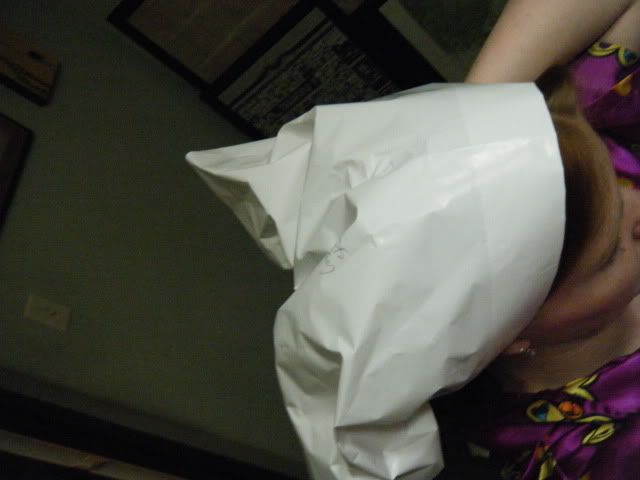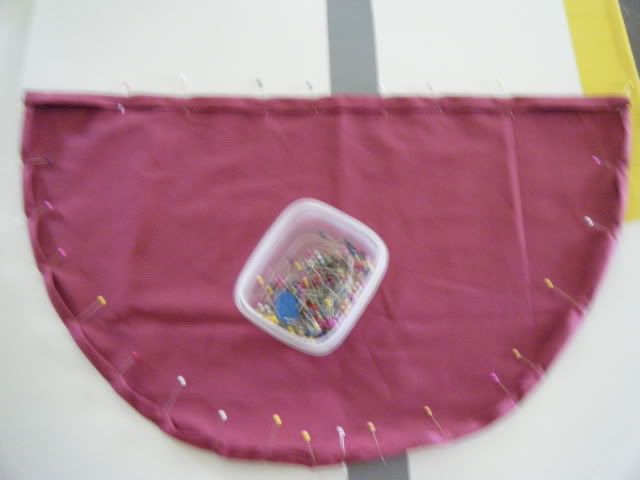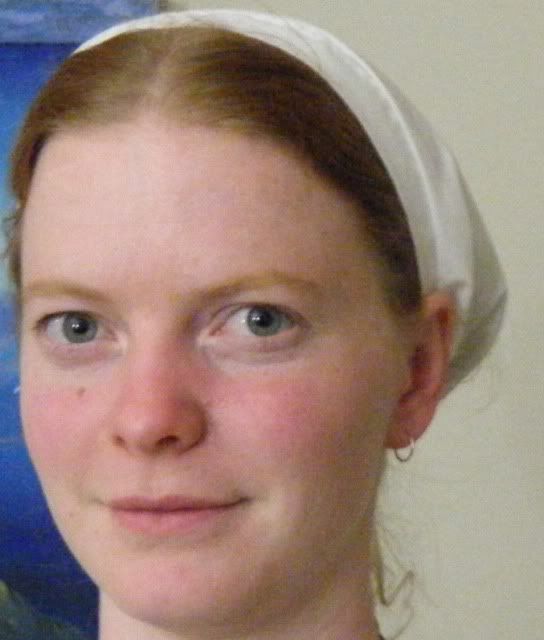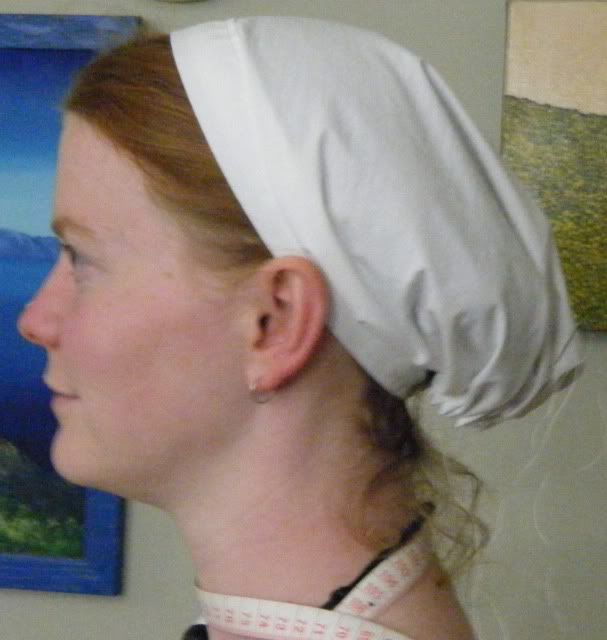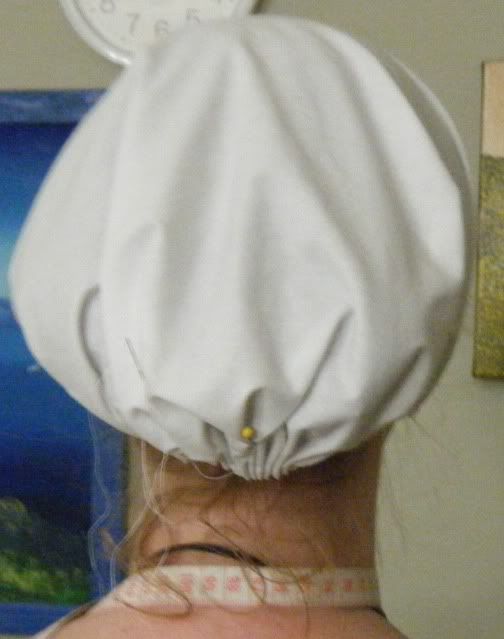I have taught myself the basics of Adobe Premiere Pro and have edited and uploaded my first video to YouTube.
Twilight Tourney 7.1
I aim to upload a selection of videos shot by Casper and Kitty at Twilight Tourney 7.1 as well as a series of videos that display the new training drills.
Saturday, 31 December 2011
Friday, 16 December 2011
Haube
So I need to make appropriate headwear to go with my Cranach gown. I've made the snood but it really needs a gold-haube inside it or as part of it. While I have the perfect gold silk, I'm really really not willing to cut it up unless I know what I'm doing... which I don't. So I decided to make an experimental haube.
Figure 1: Goldhaube detail from Ill matched Lovers (unequal couple) by Lucas Cranach the Elder 1528.
Step 1: Pattern
I spent an age online trying to find a pattern for a goldhaube, or really any haube. Nothing. There are many descriptions of what I call the sausage hats depicted in many german portraits (and some Cranach portraits too) but nothing of the Cranach snood-esk headwear. The best two references I could find were a blog written in german which suggests using a half oval who's diameter (long side) is the circumference of your head, and who's radius is the distance from forehead to nape of neck. Another blog (in english) discusses something similar but she used this as a pattern for St Bridgets headwear so had ties that looped around the head.
So I made a pattern as suggested and tried to see if it would fit.
| | | |
| The pattern with allowance for the embroidered forehead band. | Attempt at fitting paper pattern side. | Fitting paper pattern back. |
Step 2: Cut out of fabric, overlock/surge, iron and pin hems
I used the same fabric my dress was made out of so it'd match.
| | |
Step 3: Realise that if haube experiments are created out of pink fabric there needs to be a net or snood over the top. This would require tacking a net of gold cord onto the snood. Too much work for an experimental haube. New plan!
Figure 2: White-haube detail from Amorous old woman and young man by Lucas Cranach the Elder 1522.
Step 4: Repeat step two with white cotton fabric (ex-bedsheet). Cheat on wide forehead band by utilising pre-sewn edge of sheet. Machine sew folded edges.
Step 5: Measure and mark points along flat side (back) of haube every centimeter and gather.
Step 6: Check fit
| | | |
| Front: good fit and feels snug, but shows more fringe than most goldhaube images | Side: Doesn't drip down the back of the neck like many snoods. If I had more hair, bundled higher on my head I suspect it wouldn't project as far either. | Back: Sits higher on the neck but doesn't expand out the side of the head much. This may be because I don't have much hair to cover and I haven't made buns to the side of my head, rather looped up two braids. |
Over assessment: rather happy with the fit. I'm not sure how I'll fasten this, I can add a tie to the gathered section so the haube can change size as I grow more hair or I can add a clip which would ensure that it doesn't loosen during wear.
EDIT: Over christmas, unhappy with the simple gathering, I replaced it with my first ever attempt at smocking. Smocking stretches quite a bit and doesn't gather as tightly as I'd like. Future attempts will gather the back at points greater than 1cm to ensure more gather in a smaller space and I might avoid smocking for haubes.
Sunday, 11 December 2011
Plate 5 - The Ibis
Plate 5 was an interesting beast. I originally completed the back of the plate in anticipation of glazing the front as a A & S prize for my Winterfeast event. Unfortunatly for my well laid plans, the winners of the A&S competition was Mirriam and household (Abbotsford). As they won with their table decoration entry I decided that I’d make them a serving platter in a style suitable for their chosen period. This will mean some future research into 15th century plates. Unfortunately, I had a half finished plate with no real plan!
Front:
So I flipped through the images that I’d downloaded of various plates and decided that I wanted to try something different, simple and easy to execute. My own pride stopped me from replicating a rather nice yet simplistic plate featuring artichokes. The next in line was the not-kiwi bowl, so labelled because the bowl shape skews the bird motif making it look like a kiwi. This was deemed too simplistic (though I am going to try it on a small plate as a glaze experiment later I think). Instead I decided to do a different bird – the Ibis (or maybe flamingo, which ever, it’s cute!).
| |
| Figure 1: The not-kiwi Bowl (Muel, 1550-1610, V&A Museum) |
| |
| Figure 2: Inspiration for the front of Plate 5. A plate made in Manises between 1525 and 1575 (V&A). |
I have made some minor changes to this plate. I had glaze left over from the relief experiment and I still haven’t found a good replica for the ochre/yellow/gold colour that features on so many of the extant samples, so I used red. As the main Ibis is picked out in a blue colour I’ve converted this to a purple. This was in part, an experiment with the purple glaze. I think the colours have worked quite well (I’m rather enamoured of the red glaze). You can see in parts where I haven’t quite gotten the same spacing as the original plate thus the background decoration isn’t exactly the same.
| |
| Figure 3: The front of plate 5 – the Ibis plate. |
Back:
As previously mentioned, the back was created before the design of the front of the plate was chosen. To ensure a easy to document plate I surveyed a large number of images from the Victoria and Albert Museum and selected a motif that seemed common (Figure 4). The motifs utilised on the back of the plate (Figure 5) are evident in both of the plates shown in Figure 4 (and in many other examples) however these have finer brush strokes and more attention to the balance of the piece. While I believe that my work on the rear of the plate is coarse in its execution, on comparison with the reference image I think I am actually closer to the original that I thought.
| | |
| Figure 4: a) back of a plate created in Manises 1500-1525, b) back of a plate created in Manises 1525-1560. | |
| | |
| Figure 5: a) The back of plate 5, b) the inspiration for the back of the plate, Reus, 1575-1600, V&A (the back of the plate used as inspiration for plate 4) | |
Thoughts:
Watching me complete this plate triggered a lot of conversations with my housemates. The most thought provoking was the comment “you’re replicating a medieval plate, it doesn’t matter if it’s rough, that makes it look more medieval!”. Though I’ve got the upper edge as far as knowledge on 16th century pottery is concerned, I wonder if it’s a common mis-conception that medieval cultures lacked technology so couldn’t make artwork of a similar quality to those we can create (or better for that matter). I guess anyone who thought about the issue in-depth would recognise the huge number of medieval artists recognised worldwide for their superior work. Having seen a huge number of plates now, I don’t agree that rough equals medieval. Yes, I have found plates of inferior quality that still appear to have been used but I believe this is a result of apprentice work or workshops not wanting to destroy hours of labour instead selling mistakes to the middle or lower classes. I don’t think it’s fair to suggest that medieval craftsmen were less talented or cared less about their end product or were incapable of producing superior goods. I propose that while we can get a more even consistency in our products, plastic objects with obvious flashing is exactly the same product as roughly glazed pottery – not the desired end product but still something marketable.
Thursday, 8 December 2011
Brustflect designs illuminated
| |
| An example of a gold brustflect with a blackwork floral design. The blackwork design is matched by the design on the guards of the dress except in the case of portraits of Katharina von Bora. (Mary Magdalene, Cranach the Elder, 1525) |
| |
| |
| An example of a gold on gold brustflect. These are typically made of a floral brocade. Some of the brustflects have a dark edging, some are adorned with pearls along the top edge. (Young man and old woman with girl, 1545-1550) |
| |
| |
| Pearl work on gold with a central motif and floral work / spirals. Motif is different than that depicted on dress guards. (Salome, Lucas Cranach the Elder, 1530). |
| |
| |
| An example of pearlwork on gold mounted on black. The pearls in these brustflects appear to have been mounted on black cord, or surrounded by blackwork. (Portrait of a Young Woman, Lucas Cranach the Elder, 1530) |
| |
| |
| An example of pearlwork on gold, diamond shapes without a central motif. These diamonds also have a sort of star or knot design at the junctions of the diamonds. Typically these brustflects are made of a different fabric than the guards. |
Subscribe to:
Posts (Atom)
